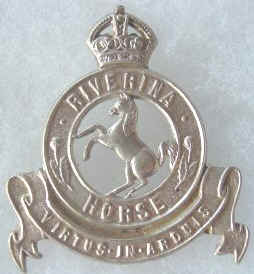 |
|
|||
|
|
||||
|
21st Light Horse Regiment |
 |
|
|
It's first CO was Captain C. D. Fuller. Headquarters were at Albion Park but later were removed to Kogarah and during the latter part of World War One to Ashfield. The badge was a horse rampant in a circle on which was the unit's title; above the circle was a crown and below it a scroll with the motto "Virtus in Arduis". The 28th was classified as Corps Mounted Troops and was attached to 3rd Light Horse Brigade (7th, 9th and 11th Regiments). During the war years, Capt P. Connolly was temporarily in command. Lt Col S. J. Shillington, V.D. commanded from 1919 to 1926. In the re-organisation of 1921, the unit became 21st Light Horse Regiment (Illawarra Light Horse). The unit's colour patch was a white triangle with a blue centre. There were a number of changes in sub-unit localities from 1921 to 1929, within the area bounded by Arncliffe, Milton and Moss Vale. The Regiment's Guidon received in 1928 bore the honorary distinction "South Africa, 1899-1902" but no World War One honours as there was no 21st Light Horse in the A.I.F. However, in 1936, the following distinctions were approved to be borne on the Guidons of the several regiments which had no A.I.F. "parent": ANZAC, GALLIPOLI, 1915; EGYPT 1915-17; PALESTINE, 1917-18. Amalgamation with 1st Light Horse Regiment (NSW Lancers) occurred in July 1929, the composite regiment being 1st/21st Light Horse Regiment (New South Wales Lancers). Four troops of 21st were disbanded, Mittagong troop was transferred to 7th and four troops were retained in 1st/21st. New South Wales Lancers badges, with the designation, 1st/21st, were used.
The 1st became Divisional Troops and
During the early part of World War Two, there were considerable changes of personnel as many left to join the A.I.F. and others were taken in to fill the gaps in the Regiment. At the end of September 1941, the 21st was placed on full-time duty and in December 1941, it was mechanized and re-designated 2nd Divisional Reconnaissance Battalion, which title was changed shortly afterwards to 21st Reconnaissance Battalion and again in September 1942, to 21st Australian Cavalry Regiment (A.I.F.) It was transferred from 1st Cavalry Division in December 1941 and its subsequent service, partly in New South Wales and partly in Queensland, was successively with 2 Aust. Div., 1Aust. Div., 3 Aust. Div., 2 Aust. Corps, 3 Aust Armoured Div. In May 1943 came the order to disband it and form the personnel into five carrier companies. As it turned out, two infantry battalion carrier platoons were also formed from personnel of HQ Sqn (Carrier Companies were to infantry divisions, tropical scale, what Divisional Cavalry Regiments were to infantry divisions, normal scale). Some of these units were sent to New Britain, New Guinea and Torres Strait. |
